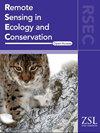Automated extraction of right whale morphometric data from drone aerial photographs
IF 4.3
2区 环境科学与生态学
Q1 ECOLOGY
引用次数: 0
Abstract
Aerial photogrammetry is a popular non‐invasive tool to measure the size, body morphometrics and body condition of wild animals. While the method can generate large datasets quickly, the lack of efficient processing tools can create bottlenecks that delay management actions. We developed a machine learning algorithm to automatically measure body morphometrics (body length and widths) of southern right whales (Eubalaena australis, SRWs) from aerial photographs (从无人机航拍照片中自动提取露脊鲸形态测量数据
航空摄影测量是一种流行的非侵入性工具,用于测量野生动物的大小,身体形态和身体状况。虽然该方法可以快速生成大型数据集,但缺乏有效的处理工具可能会造成瓶颈,从而延迟管理行动。我们开发了一种机器学习算法,从澳大利亚无人驾驶飞行器收集的航空照片(n = 8,958)中自动测量南露脊鲸(Eubalaena australis, SRWs)的身体形态(体长和宽度)。我们的方法利用两个Mask R - CNN检测模型:(i)为每个鲸鱼生成掩模,(ii)沿鲸鱼轴线估计点。我们注释了包含638头鲸鱼的468张图像的数据集来训练我们的模型。为了评估机器学习方法的准确性,我们将模型生成的身体形态测量与人工测量进行了比较。还评估了图像质量(鲸鱼姿态和水的清晰度)的影响。模型生成的体长估计值有轻微的负偏(中位数误差为- 1.3%),而体量估计值有较小的正偏(中位数误差为6.5%)。在修正了这两种偏差后,模型生成的体长和体积估计的平均绝对误差分别为0.85% (SD = 0.75)和6.88% (SD = 6.57)。误差的大小随着图像质量的提高而减小。当使用模型生成的数据来量化SRW女性身体状况的季节性变化时,我们获得了与人工测量(- 0.001565,SE = 0.000079)相似的斜率参数(- 0.001843,SE = 0.000095)。这表明我们的方法能够准确地捕捉人口水平上身体状况的时间趋势。
本文章由计算机程序翻译,如有差异,请以英文原文为准。
求助全文
约1分钟内获得全文
求助全文
来源期刊

Remote Sensing in Ecology and Conservation
Earth and Planetary Sciences-Computers in Earth Sciences
CiteScore
9.80
自引率
5.50%
发文量
69
审稿时长
18 weeks
期刊介绍:
emote Sensing in Ecology and Conservation provides a forum for rapid, peer-reviewed publication of novel, multidisciplinary research at the interface between remote sensing science and ecology and conservation. The journal prioritizes findings that advance the scientific basis of ecology and conservation, promoting the development of remote-sensing based methods relevant to the management of land use and biological systems at all levels, from populations and species to ecosystems and biomes. The journal defines remote sensing in its broadest sense, including data acquisition by hand-held and fixed ground-based sensors, such as camera traps and acoustic recorders, and sensors on airplanes and satellites. The intended journal’s audience includes ecologists, conservation scientists, policy makers, managers of terrestrial and aquatic systems, remote sensing scientists, and students.
Remote Sensing in Ecology and Conservation is a fully open access journal from Wiley and the Zoological Society of London. Remote sensing has enormous potential as to provide information on the state of, and pressures on, biological diversity and ecosystem services, at multiple spatial and temporal scales. This new publication provides a forum for multidisciplinary research in remote sensing science, ecological research and conservation science.
 求助内容:
求助内容: 应助结果提醒方式:
应助结果提醒方式:


